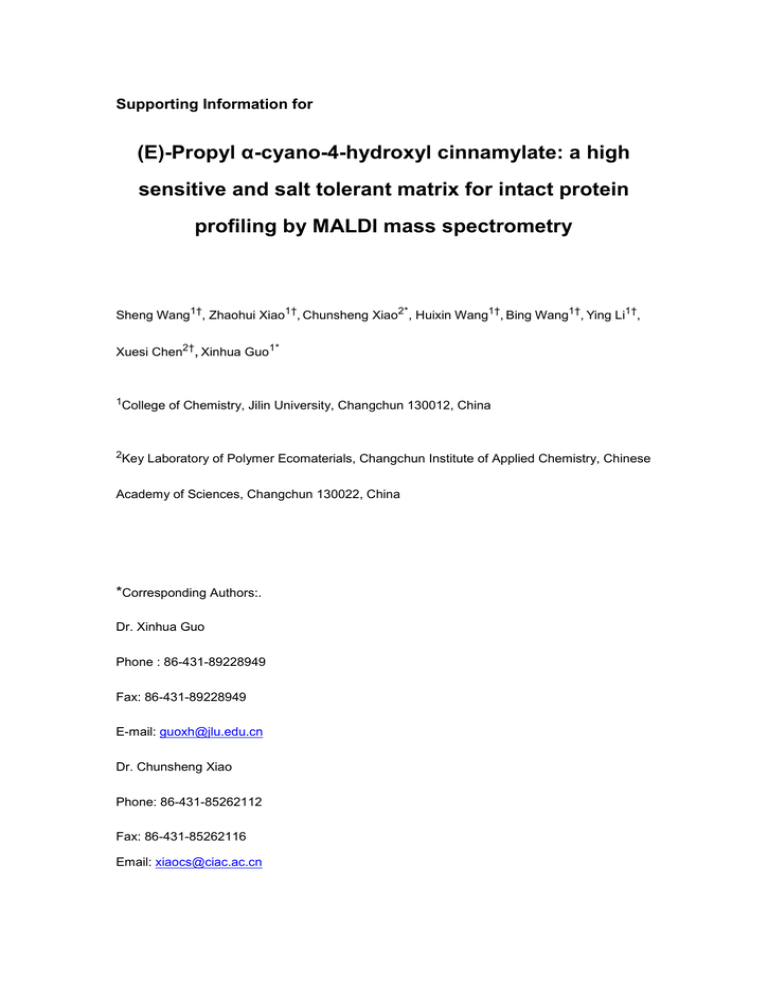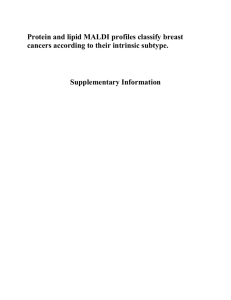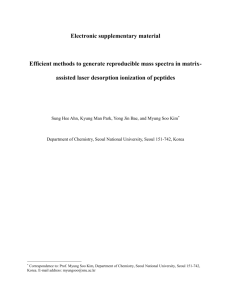Propyl α-cyano-4-hydroxyl cinnamylate: a high (E)-
advertisement

Supporting Information for (E)-Propyl α-cyano-4-hydroxyl cinnamylate: a high sensitive and salt tolerant matrix for intact protein profiling by MALDI mass spectrometry Sheng Wang1†, Zhaohui Xiao1†, Chunsheng Xiao2*, Huixin Wang1†, Bing Wang1†, Ying Li1†, Xuesi Chen2†, Xinhua Guo1* 1College 2Key of Chemistry, Jilin University, Changchun 130012, China Laboratory of Polymer Ecomaterials, Changchun Institute of Applied Chemistry, Chinese Academy of Sciences, Changchun 130022, China *Corresponding Authors:. Dr. Xinhua Guo Phone : 86-431-89228949 Fax: 86-431-89228949 E-mail: guoxh@jlu.edu.cn Dr. Chunsheng Xiao Phone: 86-431-85262112 Fax: 86-431-85262116 Email: xiaocs@ciac.ac.cn Table of content: Figure S1: UV-Vis spectra of substituted CHCAs and CHCA. Figure S2: The average S/N ratio of matrix ions (CHCA and CHCA-Cn) and analyte ion of of 100 fmol bovine insulin based the variation of laser energy (%). CHCA-Cn represents different alkyl chain-length of CHCA derivatives (n = 1-6, 8). Figure S3: Images of sample spots collected from MALDI camera. Figure S4:The relative standard deviation. Figure S5: Obtained MALDI mass spectra of transferrin from human using CHCA, SA, superDHB and CHCA-C3. Figure S6: Sample washability using CHCA-C3. Figure S7: MALDI and ESI mass spectra of pure CHCA-C3 in MS/MS mode. Table S1: The obtained mass resolution values for the singly charged molecular ion of tryspin and transferring with superDHB, SA, CHCA and CHCA-C3. Table S2: Thermochemical data of CHCA-Cn (n = 1, 2, 3, 4, 5, 6) and CHCA were evaluated by Gaussian 09. Figure S1. UV-Vis spectra of substituted CHCAs and CHCA (25 μmol L-1) in acetonitrile: a) CHCA-Cn (n=1, 2, 3, 4, 5, 6) and CHCA. b) CHCA-Cn (n=8, 10, 12), CHCA-isopropylester, CHCA-isobutylester and CHCA-tert-butylester. Figure S2. The average S/N ratio of (left) matrix ions CHCA or CHCA-Cn (n = 1-6, 8) and (right) analyte ions of 100 fmol bovine insulin versus the variation of laser energy (%). Different matrices or analyte ions was marked on the left top corner of each figure. Sample preparations in figure a-p were performed with dried-droplet method and figure q and r were prepared with two layer method. CHCA were saturated in 50% ACN/0.1% aqueous TFA (v/v). CHCA-Cn (n=1, 2, 3, 4, 5, 6, 8) solution was prepared in 50% ACN/0.1% aqueous TFA (v/v) at 1 mg mL-1. Each S/N ratio value shown in the Figure was the average of 9 single-shot spectra. Figure S3. Images of sample spots collected from MALDI camera. 1μL of trypsin-matrix mixture was deposited on the steel target spot and left to dry. a) superDHB with DD method, b) SA with TL method, c) CHCA with TL method and d) CHCA-C3 with DD method. Figure S4. Normalized [tryspin]+ signal-to-noise ratio of tryspin obtained from 16 different spots by using a) SuperDHB with DD method, b) SA with TL method, c) CHCA with TL method and d) CHCA-C3 with DD method. The tryspin loading is 1 pmol. The relative standard deviations (RSD) of the data are presented as bar graphs. For superDHB, all spectra were collected from needlelike crystals at the rim of crystal. For SA, CHCA and CHCA-C3, all spectra were collected from random spots on the crystal. Figure S5. Obtained MALDI mass spectra of transferrin (m/z: 77064 KDa, 1 pmol) from human using a) CHCA; b) SA; c) superDHB and d) CHCA-C3 as matrix. Different charge peaks are labeled in the Figs. Figure S6. MALDI mass spectra of myoglobin (1 pmol) obtained using CHCA-C3 as matrix in the presence of (a) 4M urea, (b) 2M NH 4HCO3, and (c) 680mM KH2PO4 without wash; after one wash (second line: d, e, f); three washes (third line: g, h, i). Peak intensity and signal to noise ratio can be inferred from the coordinate in the upper right corner of each mass spectrum. Figure S7. a) Obtained MALDI mass spectrum of pure CHCA-C3 in positive-ion mode; b) MALDI MS/MS spectrum in the MS/MS lift mode using collision induced dissociation gas (air), where the protonated CHCA-C3 (m/z: 232.119) as precursor ion was fragmented; c) ESI MS/MS spectrum of CHCA-C3 (m/z: 232.1) in positive ion mode with 7.0 eV condition energy. Table S1. The obtained mass resolution values (full width at half maximum, FWHM) for the singly charged molecular ion of tryspin (m/z: 23982) and transferrin (m/z: 77064) with superDHB, SA, CHCA and CHCA-C3. The sample loading were 1 pmol, 0.1 pmol and 10 fmol, respectively. Protein and concentration SuperDHB SA CHCA CHCA-C3 trypsin (1 pmol) ~296 ~260 ~280 ~290 trypsin (0.1 pmol) ~180 ~250 ~66 ~302 trypsin (10 fmol) – – – ~260 transferrin (1 pmol) ~89 ~51 ~52 ~47 transferrin (0.1 pmol) ~75 ~33 ~30 ~43 transferrin (10 fmol) – – – ~42 “–”represent not detectable. Table S2. Thermochemical data were evaluated by B3LYP DFT molecular orbital approach with 6-31+G (d, p) and 6-311+G (2d, 2p) basis sets in Gaussian 09. PA(M) [a] IE(M) [b] EA(M) [c] IE-EA [d] kJ/mol eV eV eV CHCA 854.3 8.25 1.50 6.75 CHCA-C1 869.6 8.12 1.39 6.73 CHCA-C2 877.6 8.04 1.37 6.67 CHCA-C3 879.5 8.03 1.37 6.66 CHCA-C4 878.5 8.05 1.37 6.68 CHCA-C5 879.2 8.05 1.38 6.67 CHCA-C6 879.6 8.04 1.38 6.66 Matrices PA(M) [a] represents the proton affinities of matrix molecules. IE [b] and EA [c] indicates ionization energy and electron affinity. IE-EA [d] represents the value of reaction enthalpy.



